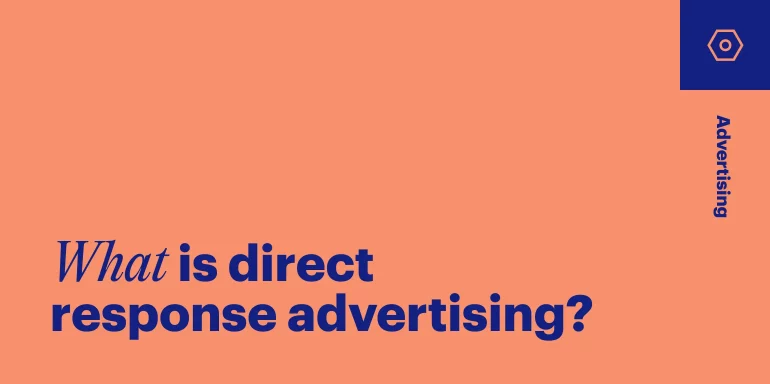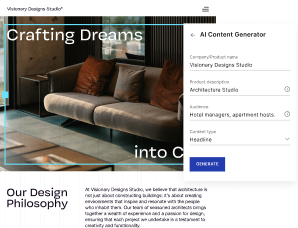Have you ever abandoned purchasing a product online because it’s a next-paycheck purchase? Only to later discover that the product is stalking you everywhere you go—you see an ad for it on Facebook, Instagram, and news websites. That’s direct response marketing in action, and here’s what it is.
What is direct response marketing?
Direct response advertising is a marketing strategy that aims to prompt immediate action from audiences, such as making a purchase, signing up for a free trial, or making a reservation.
This type of marketing is measurable, accountable, and highly targeted. It taps into what Nobel Prize laureate Daniel Kahneman called System 1 thinking—the fast, intuitive, and emotional part of our brain. Direct response ads trigger quick, spontaneous reactions to get consumers to act impulsively before their more analytical System 2 thinking can take over.
Direct response marketing vs. brand marketing
While direct marketing aims to elicit a specific immediate action that can be measured, brand marketing helps brands make long-term image and emotional connections with their audience. These two strategies work hand in hand: the trust and recognition built through brand marketing ads enhance the effectiveness of direct response ads, and insights drawn from direct response activities can fine-tune overall brand strategies.
Direct response marketing strategy must-haves
Crafting a direct response strategy that resonates with potential customers isn’t a simple, cookie-cutter process. It demands a blend of tried-and-tested techniques tailored to your unique audience. Let’s take a look at some of them.
1. Personalization
Customized advertising that speaks directly to distinct groups can significantly boost engagement—91% of consumers are drawn to brands that recognize their preferences. Think about who your audience is. Pin them down by factors like income, device usage, or hobbies. The more precise your audience profiling, the better your chances of hitting the mark. But there’s a fine line to walk. Tread carefully around personal details to avoid overstepping, as was the case with Target’s marketing misstep.
Target’s customer tracking technology, developed by a marketer named Andrew Pole, once revealed a teenage girl’s pregnancy her parents hadn’t known about. In a Target near Minneapolis, a father was furious when he received coupons for baby items addressed to his high school daughter. He accused the store of encouraging teen pregnancy. The manager, initially confused, confirmed the coupons’ contents and called the father to apologize a few days later. In a phone conversation with the manager, the father admitted his mistake, saying that his daughter was indeed pregnant, but he hadn’t known about that at the time.
2. A sense of urgency and scarcity
Let’s admit it: we often purchase things driven by a flash sale rather than by necessity. Urgency leverages our instinct to value time-sensitive opportunities over product benefits. Scarcity, on the other hand, can make an item seem more desirable, just like Birkin bags by Hermès.
To amplify urgency and scarcity in your marketing:
- Set deadlines with a prominent countdown timer on the site and in an email: “Sale ends in …. hours!”
- Highlight price increase: “Prices go up tomorrow!” notices on product pages
- Use time-related copy in email campaigns with phrases like “Last chance to save!”
- Show real-time updates about the product: “10 customers have added this item to the shopping cart”
- Add a notification in the shopping cart with an image of an item: “These are selling fast!”
- Display the number of items available: “Only 3 left in stock”
These are just some examples of how to encourage customers to act quickly to avoid letting a potential benefit slip away.
3. Focus on the offer and its value
Being offer-centric in direct response ads means the ad is built around a strong value proposition that clearly communicates the benefit to the customer. The offer is the star of the show; it’s what catches the eye and hooks the potential customer’s interest.
The CTA (Call to Action) is the direct response part—it’s the ‘what now’ that guides the customer on how to take advantage of the offer. Use sharp, benefit-focused language tailored to speak directly to the customer’s needs or desires.
Customer-centricity
Gone are the days of the dry, serious sales pitch—today’s consumers want to feel valued, not just sold to. It’s about creating a connection that goes beyond the transaction.
Here’s how to put your customer at the heart of your communication:
- Embrace storytelling: Stories transform plain information into something personable and engaging. For example, use testimonials to show how your product or service has improved someone’s life or addressed a challenge they faced.
- Highlight the product positives: People resonate more with what they stand to gain. Rather than listing the features of your product, emphasize the benefits. Shift from “Our hotel rooms include free Wi-Fi” to “Enjoy the convenience of staying in touch with complimentary Wi-Fi.”
- Demonstrate empathy: Make it clear you understand and care about your customer’s needs. For instance, “Morning rushes are hard. That’s why our fast-brew coffee maker delivers quality coffee quickly—so you can focus on taking on the day.”
Direct response advertising types
Email campaigns
Direct response advertising can be super effective, especially with email campaigns. Ensure your emails are engaging, on-point, and persuasive enough to cut through the noise of the cluttered email box.
Consider these tips for fine-tuning your email campaigns:
- Be concise: Your email should be short and sweet, ideally not extending beyond the length of two screens.
- Message up front: State your offer or message right at the start. Highlight the benefits early on to grab attention.
- Reader-focused writing: The email should speak to how it benefits the reader’s life, not just how great the product is.
- Visually pleasing layout: Employ bullet points and short sentences, and include plenty of white space for easier reading.
- Clear CTA: Make the next steps obvious, whether it’s downloading an ebook, confirming attendance, or visiting your store. Use compelling verbs like ‘grab,’ ‘discover,’ or ‘explore.’
- Apply psychology: Leverage tactics like the fear of missing out (FOMO) or the attraction to ‘free’ offerings to boost engagement. Keep options straightforward to prevent decision fatigue.
Landing pages
Offering clients too many options, like we often see on a homepage, can impact their decision-making process. Psychologists refer to this as the paradox of choice. So, what’s the best strategy for getting them to focus on something specific?
Use the power of landing pages.
A landing page is a dedicated webpage designed to drive a specific action, such as a product purchase or newsletter signup. Landing pages focus on converting visitors into leads or customers and feature a single, clear call to action.
There are two main types of landing pages:
- A lead generation page for gathering visitor info in exchange for something valuable.
- A click-through page for nudging users toward a specific action on another page.
Best practices for high-converting landing pages:
- Craft concise headlines that directly state the value of your offer
- Use high-quality visuals that capture attention and align with your product or service
- Include testimonials or client logos to build trust and credibility
- Keep your text brief and focused on the benefits, using bullet points for clarity
- Use an action-oriented CTA like “Download Now” or “Join for Free”
- Remove unnecessary elements that don’t contribute to the main goal of the CTA
- Optimize your page for quick loading, which is crucial for retaining visitor interest
- Ensure the page looks great and functions well on mobile devices
Retargeting vs. Remarketing
Retargeting is a direct response marketing strategy that targets website or social media visitors with online ads to encourage them to complete a conversion after moving away from it.
It uses tracking pixels (code snippets for monitoring user behavior) to gather visitor data, enabling more personalized and effective advertising.
There are two main ways to target ads: behavioral and contextual targeting. Behavioral targeting is based on collecting information about a customer’s past online actions—it’s very detailed because it uses a lot of personal data.
Conversely, contextual targeting is more about fitting the ad to the current webpage or content. Choosing in favor of behavioral or contextual targeting depends on what you’re aiming to achieve with your ads and how your audience feels about privacy.
While retargeting focuses on engaging potential customers, remarketing is essential for re-engaging those already familiar with your brand. Popular remarketing techniques include email campaigns and paid advertisements. Interestingly, with a 16% drop, email inboxes aren’t as packed these days.
This also opens up an excellent opportunity for businesses to reach out and remind previous customers about what’s great about their products and tempt them with new deals.
Native ads
Almost 40% of users in the U.S. utilize ad blockers. And this isn’t a hot take—it’s common knowledge that people don’t like annoying and repetitive ads that may invade their privacy.
What’s great about native ads is that they’re sponsored content that blends in with the platform’s regular content, offering a sales message with a direct CTA once the reader is already engaged.
These are some of the best practices for creating native ads:
- Ensure the content is readable and resonates with the target audience
- Highlight what the product can do for the reader rather than just its features
- Sweeten the deal by offering helpful info, fun facts, or freebies
- Use actual customer stories and testimonials to boost trust
- Add a hint to check out the website or snag the product
If you’re struggling with writer’s block and could use some help crafting persuasive and native copy, you can use AI-assisted tools like Instapage’s AI Content Generator.
QR Codes in advertising
QR codes made a major comeback during the pandemic, and they’ve stuck around as a valuable tool in direct response ad campaigns. Their magic lies in streamlining the customer journey, swiftly bringing potential customers from the physical realm to where you want them: a website, a landing page, or even a spot for a free download.
Here are some tips on how to make the most out of your QR codes:
- Place QR codes where your target audience is most likely to scan them. (print ads, on product packaging, or at event booths)
- Briefly guide users on how to scan the QR code, especially if your target demographic is not very tech-savvy
- Ensure your QR code takes a user to a specific action like signing up for a newsletter or availing of a special offer
- The destination page must be optimized for mobile viewing since QR codes are primarily scanned with smartphones
- Offer incentives for scanning the QR code, such as discounts or valuable information
If you think that QR codes are not attention-worthy in the eyes of potential customers, check out a growing trend of QR code art. You can easily transform these functional squares into visually appealing pieces that don’t just direct traffic but can also be used creatively to stand out.
Exit-Intent Pop-Ups
Pop-ups usually show up on a website when you do certain things to grab your attention or tell you something important. A study using eye tracking found that users typically glance at a pop-up within 1.3 to 1.5 seconds and then immediately close it.
No wonder some people see them as overly intrusive and annoying. In this light, relying on exit intent pop-ups is better. They give you a last-second opportunity to engage with users just as they’re about to leave your website.
Here’s how you can use a respectful approach to designing exit intent pop-ups that users won’t be tempted to skip:
- Create content that’s directly relevant and present it within a design that’s straightforward and clear-cut in its message
- Time your pop-ups thoughtfully to avoid interrupting the user’s experience
- Implement A/B testing to determine which pop-up connects more effectively with your users
- Guarantee that your pop-ups can be easily closed if the visitor chooses to do so
- Make your pop-ups mobile-friendly, ensuring they are as functional as they are on desktops
- Be mindful of various privacy regulations, like GDPR
Otherwise, you can consider alternatives to pop-ups, such as slide-ins, banners, or embedded CTAs within the content, which can be less disruptive but still effective.
How to track your marketing campaign success
In 2024, with all its upcoming economic twists and turns, it’s super important to keep tabs on some key metrics to get a handle on how your direct response marketing is doing:
- Conversion Rate: Look at what percentage of your website visitors are taking action—like buying something or signing up. If this number is climbing, your campaign is hitting the mark.
- Response Rate: This is all about how many people are engaging with your campaigns compared to how many you’ve reached out to. It’s a straightforward way of seeing if your messages are making an impact.
- Cost per Acquisition (CPA): Keep track of what you’re spending to win over a new customer, considering your ads, tech tools, and the effort of your team
- Average Order Value (AOV): This tells you how much money customers typically spend on an order. It’s a great indicator of how well your marketing is driving higher-value sales
- Return on ad spend (ROAS): ROAS helps you see if the money you’re putting into your marketing is paying off in terms of revenue
- Lifetime Value (LTV): LTV predicts the total revenue a customer will bring in during their time with your company. By understanding LTV, you can make smarter decisions about how much to spend on getting new customers and keeping the ones you have.
With a clear eye on these metrics, you can sharpen your campaigns and aim for better outcomes. Remember, the key to marketing success is to watch, learn, and constantly improve.
Direct response advertising examples
Filmsupply (landing page)

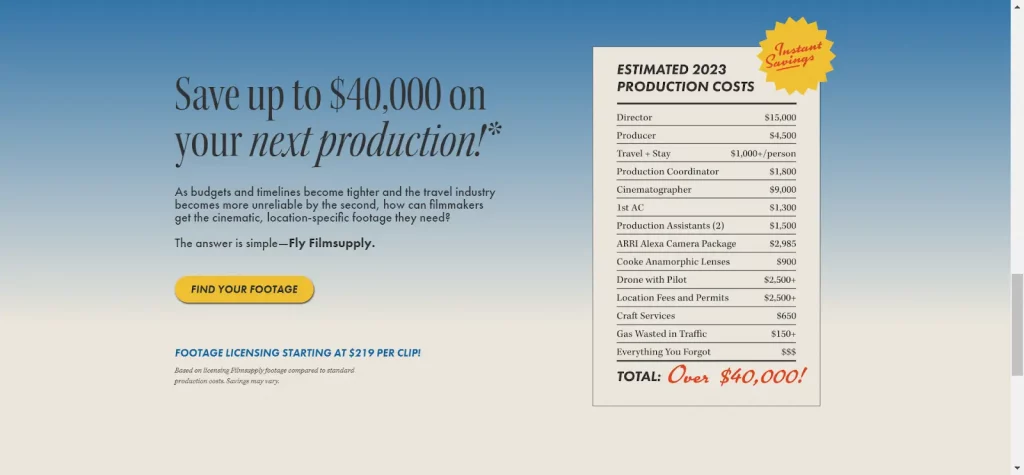
The Filmsupply landing page is offer-focused and features potential savings of up to $40,000 on production costs.
This is a significant incentive for filmmakers and creates a subtle sense of urgency by nudging visitors toward taking immediate advantage of the offer. The page features a clear call-to-action with the Find Your Footage button, which is strategically placed to encourage immediate engagement from visitors.
The nostalgic visuals add aesthetic appeal and resonate with the craft of filmmaking, potentially reminding visitors of the industry’s rich history and the value of high-quality production footage.
Banana Republic Factory (a pop-up notification in the cart)
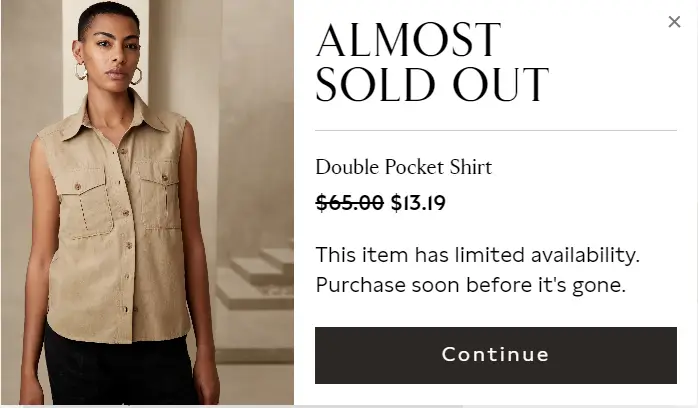
This banner pops up after customers browse the shopping cart for a few seconds. The message creates a sense of urgency and scarcity. It informs the potential customer that the item added to the cart is almost sold out, encouraging immediate action to avoid missing out.
The discounted price is clearly displayed and backed up with a CTA. The notification is easy to close and doesn’t irritate users if they’re uninterested in the purchase.
IMAGE Skincare (email remarketing campaign)
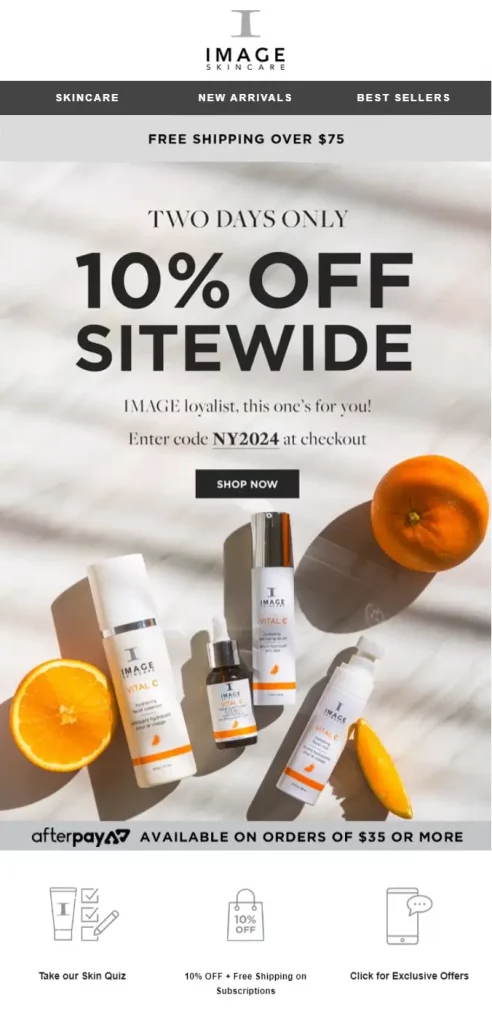
The IMAGE Skincare ad combines urgency and personalization, declaring “TWO DAYS ONLY” for a “10% sitewide” discount and addressing a customer as an “IMAGE loyalist.”
The offer is placed to capture immediate attention and reinforced by free shipping and a clear “SHOP NOW” CTA button. Visuals of the product, together with vibrant oranges, underline the brand’s vitality and natural ingredients. At the same time, options like Afterpay and interactive elements, such as a skin quiz, can further engage the customer and potentially allow for collecting more data for future retargeting or remarketing efforts.
Good Ranchers (pop-up)
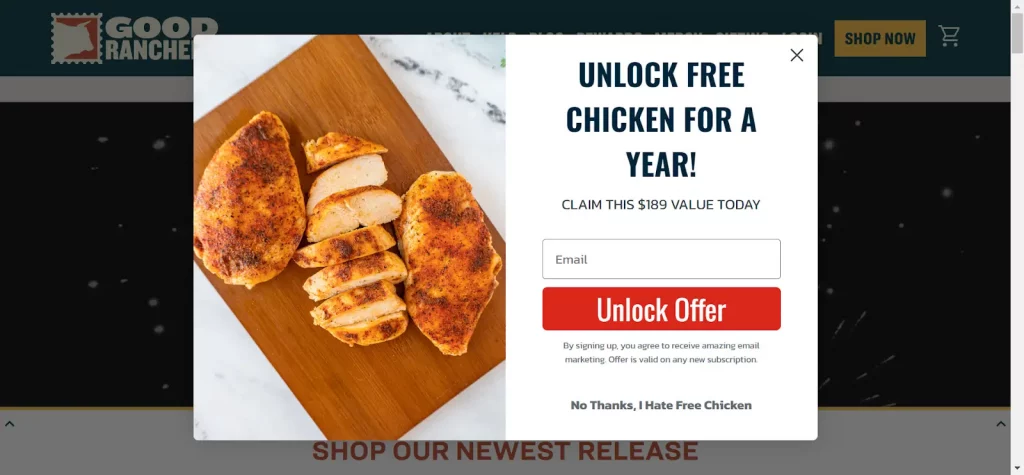
The header “UNLOCK FREE CHICKEN FOR A YEAR!” alongside the subtext “CLAIM THIS $189 VALUE TODAY” creates a sense of urgency for the user to take immediate action.
The value proposition is shown upfront, and the offer targets a specific audience—customers interested in regular meat purchasers. There’s a clever use of reverse psychology with the message “No Thanks, I Hate Free Chicken” for opting out. The pop-up has a mouth-watering image of cooked chicken, enticing the user.
Get started on your direct response marketing campaigns
With direct response ads, you get to actively engage users, sparking a direct and immediate response from them. Targeted, personalized advertising techniques help transform casual browsing into decisive action.
With that in mind, check out the Instapage AdMap feature. And, if you want to connect your ads to personalized experiences and elicit that conversion action, you need to try Instapage’s AdMap® feature. With the feature, you can connect page experiences to ads you’ve already created or build new personalized pages from within the feature.
AdMap® helps you manage campaigns more efficiently by visualizing all your ads and matching landing pages in one place, increasing conversion rates, and decreasing cost-per-acquisition by improving your ad-to-page personalization ratio like the Farmer’s Dog did with their ad and landing page.
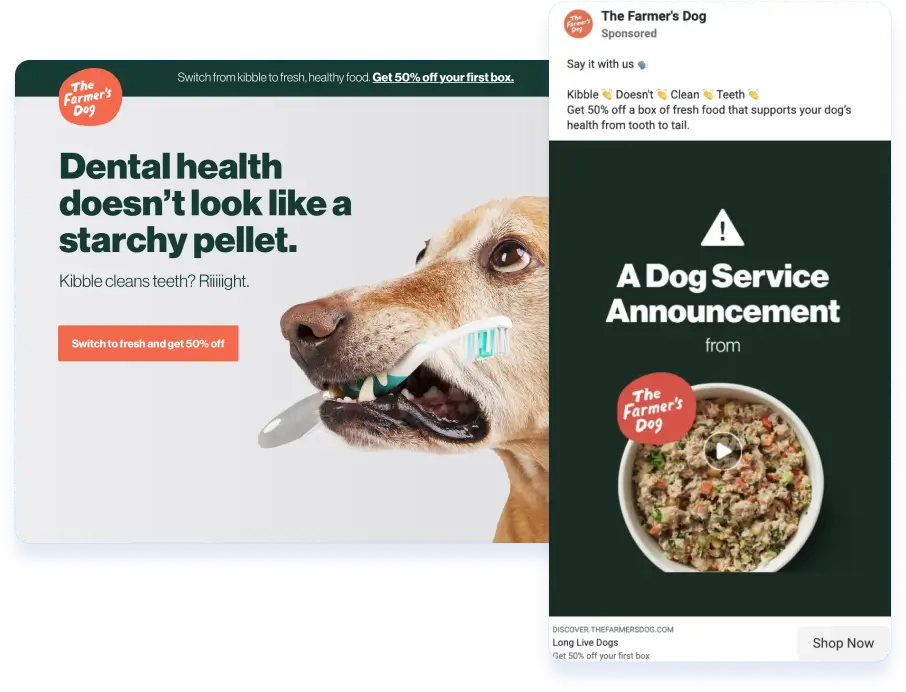
Want to start creating more personalized experiences? Give Instapage and AdMap® a try. Sign up for a 14-day free trial today, and make every click count.

Try the world's most advanced landing page platform with a risk-free trial.
